Abstract
To accurately color the clothing of textile enterprises, many scholars have proposed intelligent color-matching models. However, these intelligent color-matching models still have problems with incomplete color-matching functions and low color-matching accuracy. To solve the above problems, this study optimized the convolutional neural network (CNN) algorithm using the genetic algorithm (GA), extracted data through the GA, and then processed the information using the CNN algorithm. Besides, based on the optimized algorithm, an intelligent color-matching model was constructed. To verify the performance of the proposed color-matching model, the superiority of the optimization algorithm (PSO) was first tested. The results showed that the accuracy of the PSO reached 98%, and the loss value of the algorithm function was only 0.02, significantly better than other algorithms. Further analysis of the performance of the intelligent color-matching model based on PSOs showed that the accuracy of the model’s color matching reached 98%, and the matthews correlation coefficient index of the model was 1. The performance of this color-matching model was superior to other models. In practical applications, the model had an average color difference of only 0.51, 0.49, and 0.47 for the three primary colors of red, green, and blue, with small color differences and high color-matching accuracy. From the above results, it can be seen that the intelligent color-matching model proposed in the study can improve the accuracy of color matching and reduce color difference, thereby improving the efficiency of clothing color matching in textile enterprises and promoting the development of the textile industry and other color-matching industries.
1 Introduction
With the continuous advancement of artificial intelligence technology, intelligent learning models have been widely utilized in various fields, and the textile industry has also introduced computer-intelligent color-matching learning models [1]. Many domestic and foreign scholars have organized research on intelligent color-matching learning models. For example, Guan et al. proposed an intelligent color-matching prediction model with a genetic algorithm (GA) and extreme learning machine to improve the accuracy of predicting the dyeing formula of precious wood. The model was compared with other models in experiments, and the outcomes denoted that the average relative deviation of the model for color formula was 0.262, which was lower than other comparison models and could achieve good outcomes in wood production [2]. Zhang et al. designed an intelligent color-matching behavior model based on product color-matching methods to address the issue of insufficient team collaboration ability in research and mechanism design of group collaboration practices. The model was compared with other current behavior models, and the experiment outcomes indicated that the model could find the optimal team collaboration model, improving team collaboration efficiency by 30% [3]. Yang et al. designed a color-matching model based on the Kubelka-Munk theory to address the issue of existing color-matching systems being unable to dye specific textile materials. Comparing this model with other models in experiments, the results showed that the coverage rate of textile materials reached 97.87%, which is much higher than other models [4]. However, these intelligent color-matching learning models still have problems such as low color-matching efficiency, poor stability, and low color-matching accuracy [5]. So, proposing an intelligent color-matching learning model that can improve the accuracy and efficiency of textile color matching is an urgent problem to be solved.
The convolutional neural network (CNN) algorithm is widely used in learning models due to its strong feature extraction ability, parameter sharing, and strong visualization of points. GA is widely used in learning models due to its powerful global search ability [6,7]. Many scholars have studied the above algorithms. For example, Kattenborn et al. indicated a CNN-based machine learning model to improve the ability of remote sensing technology to recognize and represent plant information in time and space. The model was compared with other models, and the experiment outcomes indicated that the CNN-based machine learning model could raise the accuracy of remote sensing technology in extracting vegetation information to 98.9% [8]. Lu et al. designed a prediction model with the CNN-BiLSTM-AM algorithm to solve the phenomenon of rapid and unpredictable stock price fluctuations in the stock market. Through comparative experiments with other models, it was found that the model improved the accuracy of stock price prediction by 47.78%, providing a reliable way for investors to make stock decisions [9]. In response to the problems of slow convergence speed and low recognition accuracy of backpropagation neural networks, Zhang et al. optimized it using GA and proposed the GA-ACO-BP prediction model. The model was compared with previous models in experiments, and the experiment outcomes denoted that the optimized model could achieve a 100% reporting rate and 98.38% prediction accuracy, with good prediction performance and application prospects [10]. To solve the widespread delay problem between cloud data centers and medical devices in medical network physics systems, Yu et al. designed a medical physics system based on a hybrid GA. The system was compared with other current systems and the experimental results showed that the system shortened the delay time between devices to 0.003s, which is much smaller than other models [11]. The specific comparison results of the above models are shown in Table 1.
Comparison of paper models
| Author | Model | Advantage | Disadvantage |
|---|---|---|---|
| Guan et al. | GA-ELM intelligent color-matching model | Low deviation in wood dyeing | High computational complexity |
| Zhang et al. | Intelligent color-matching behavior model based on product color-matching method | High efficiency of team collaboration | Lack of adaptive ability |
| Yang et al. | Kubelka-Munk color-matching model | High coverage of color-matching material recognition | Theoretical limitations |
| Kattenborn et al. | CNN machine learning model | High accuracy of information extraction | High data demand |
| Lu et al. | CNN-BiLSTM-AM prediction model | High prediction accuracy | Large computational load |
| Zhang et al. | GA-ACO-BP prediction model | Fast convergence speed | Low prediction performance |
| Yu et al. | GA medical physics system | Short delay time | Poor information extraction performance |
Therefore, this study will use the GA to improve the CNN algorithm and apply the improved algorithm to the intelligent color-matching learning model to raise the accuracy of the model for color-matching schemes of textile industry color samples. The innovation of this study lies in using GA to optimize the CNN algorithm and designing a new intelligent color-matching learning model based on the optimized algorithm, providing a new algorithm foundation for the intelligent color-matching field in the textile industry. The contribution of this study is that the proposed intelligent color-matching model can reduce color uncertainty, shorten product development cycles, and improve production efficiency by improving color-matching efficiency. Moreover, digital color matching can precisely control the amount of pigment used, reducing costs. In addition, this intelligent color-matching model can also be used to improve work efficiency in other industries such as coatings, paints, and printing.
2 Methods and materials
2.1 Improved CNN algorithm incorporating the GA
The current intelligent color-matching model has the disadvantages of low feature information extraction efficiency, high cost, and weak anti-interference ability [12,13]. To improve the color-matching efficiency, a CNN algorithm with strong image recognition ability and low computational complexity was introduced to optimize it, in the hope of improving the color-matching efficiency of the model [14]. The basic flowchart of the CNN algorithm is shown in Figure 1.
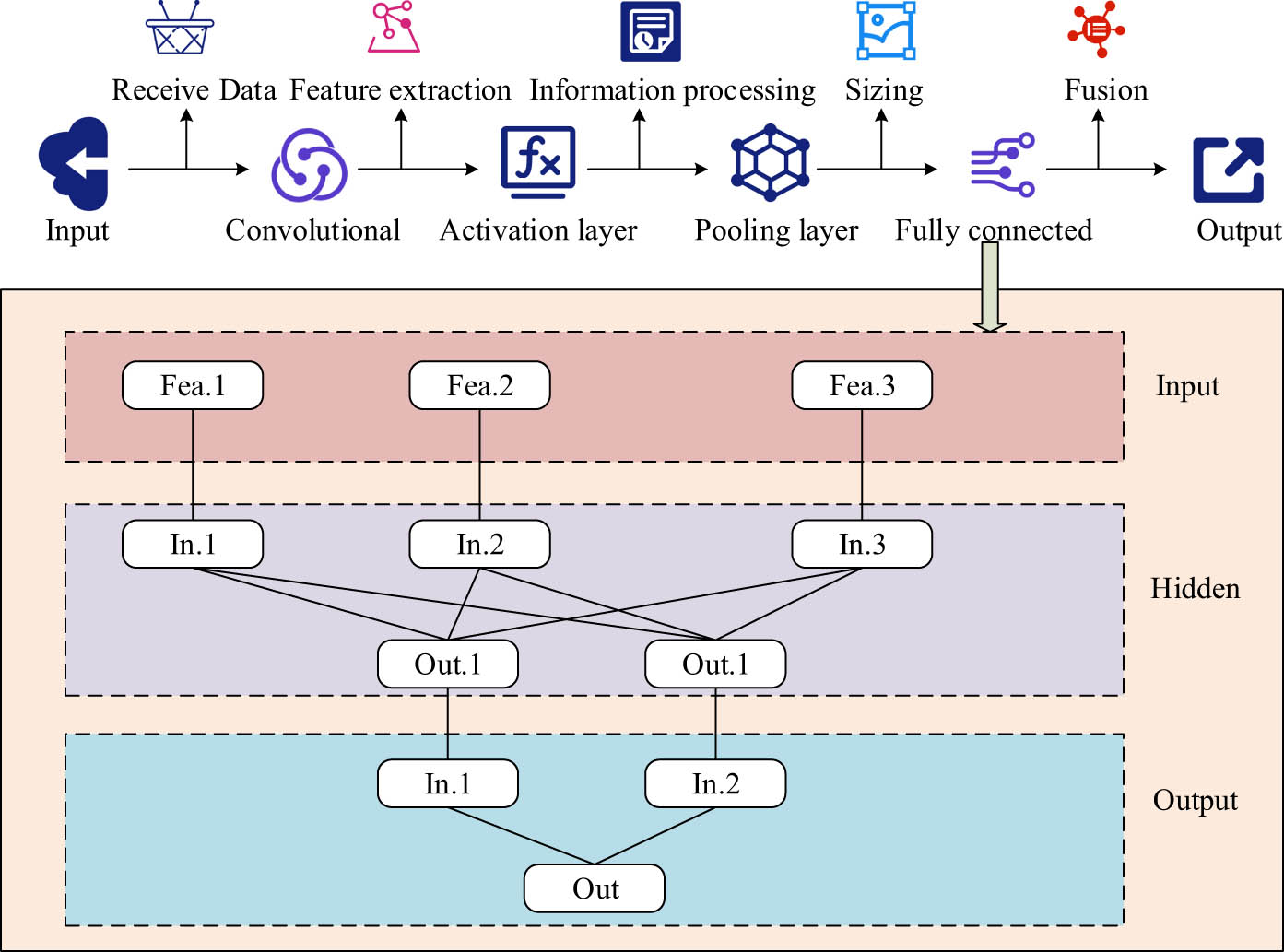
Basic flowchart of the CNN algorithm.
In Figure 1, the basic process of the CNN algorithm is to receive input learning samples in the input layer, then transfer the learning samples to the convolutional layer, extract the features of the input data through convolution operations in the convolutional layer, and extract the spatial structure of the input samples through convolution calculations in the convolutional kernel. Subsequently, the information is passed into the activation layer and processed using an activation function. The extracted features are then input into the pooling layer to adjust the size of the feature mapping. The adjusted information is input into the fully connected layer for fusion. The fully connected layer is divided into three layers: input layer, hidden layer, and output layer. These three layers are used to weigh and sum the feature information received from the pooling layer to obtain a comprehensive feature representation. Finally, it outputs the adjusted feature information. The convolution operation method of the convolutional layer in the CNN algorithm is shown as follows:
where
where
The calculation method for the linear rectification function is denoted as follows
After enhancing the linear separability of features through the activation layer, the pooling layer performs pooling operations on them, including max pooling and average pooling. The expression for the max pooling layer is shown as follows:
The calculation method for average pooling is denoted as follows:
In Eqs. (5) and (6),
In Eq. (7),
In Eq. (8),
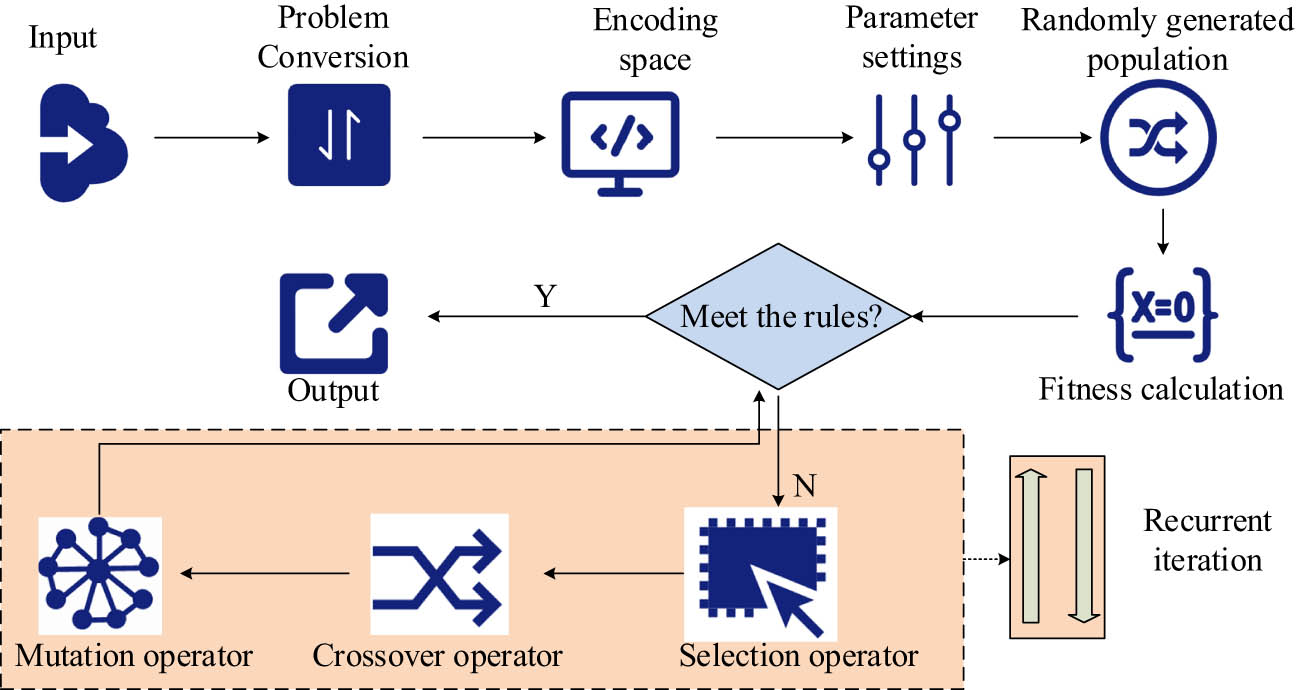
Basic flowchart of GA.
In Figure 2, the GA performs binary encoding on the received data information, converts it into information that can be recognized in the encoding space, and then inputs all information and parameters into the encoding space. It sets the parameters, preprocesses the input data, randomly generates the initial population, and then performs fitness calculations on it to see if it meets the termination rule. If it does, it will output the optimal data directly. If it is not satisfied, it will undergo evolutionary operations such as selection, crossover, and reversal, and then its fitness will be calculated until the termination rule is met. The encoding in the algorithm process uses binary encoding to convert the data. Each variable is binary encoded to obtain the encoding information composed of variables. The encoding length calculation is shown as follows:
In Eq. (9),
In Eq. (10),
In Eq. (11),
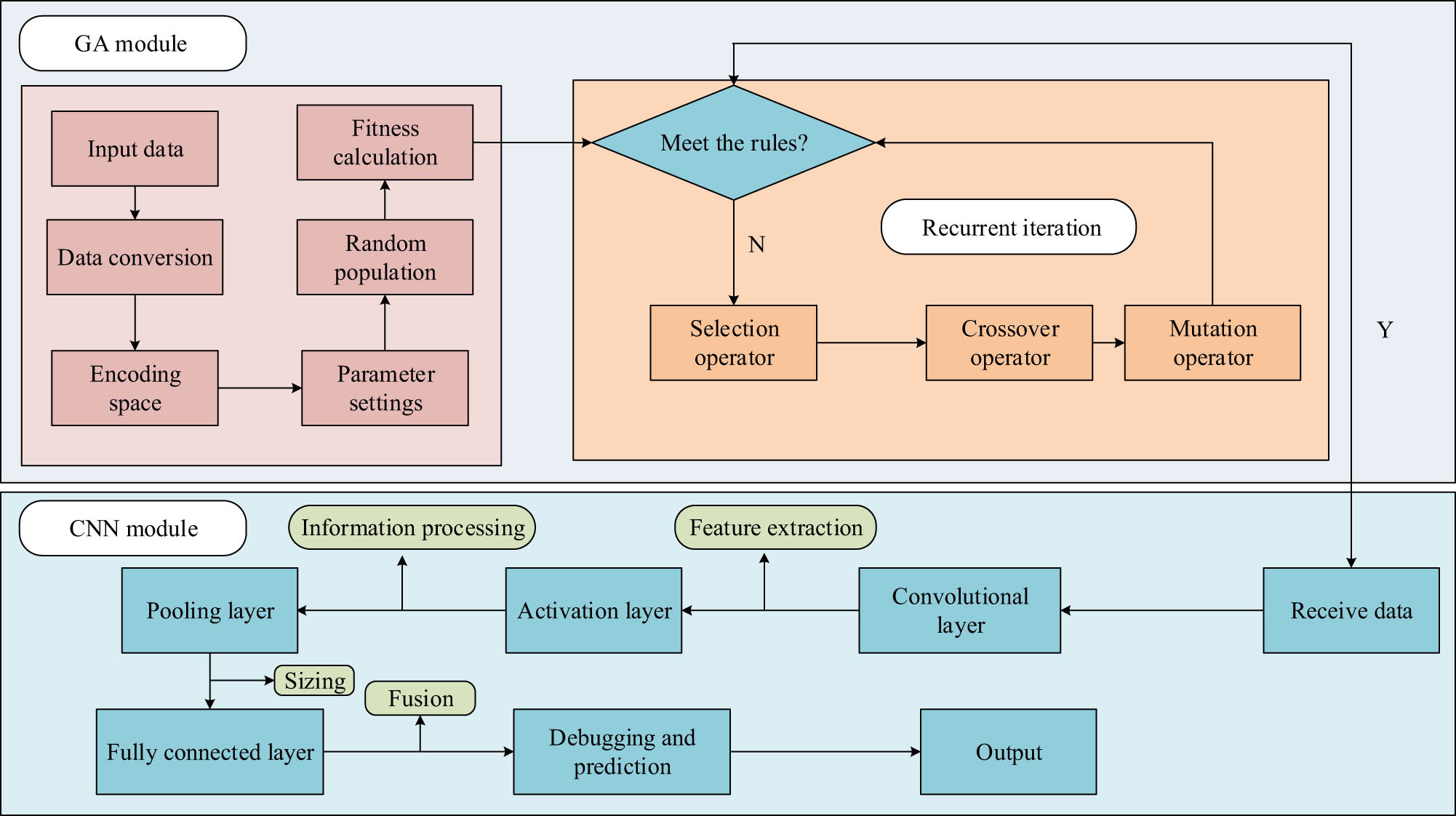
Improved CNN algorithm flowchart.
In Figure 3, the improved CNN algorithm preprocesses the global data through the GA module, excludes irrelevant information from the global data through the principle of survival of the fittest in the GA, inputs the extracted data into the input layer of the CNN algorithm, extracts feature information through convolutional layers, pooling layers, and fully connected layers, and adjusts the size of feature information. Finally, debugging is performed to output prediction information. The ability to use GA for global search improves the limitation of the CNN algorithm to local search and reduces the computational complexity of the CNN algorithm.
2.2 Construction of an intelligent color-matching learning model based on the GA-CNN algorithm
To raise the color-matching technology in the textile industry, an intelligent color-matching learning model is introduced. However, currently, the color-matching efficiency of this model is low; there are few platforms to use, and its functions are not complete [18]. To address this issue, the GA-CNN algorithm with image recognition capability, low computational complexity, and global search capability is integrated into the intelligent color-matching learning model. The flowchart of the intelligent color-matching model using the GA-CNN algorithm is shown in Figure 4.
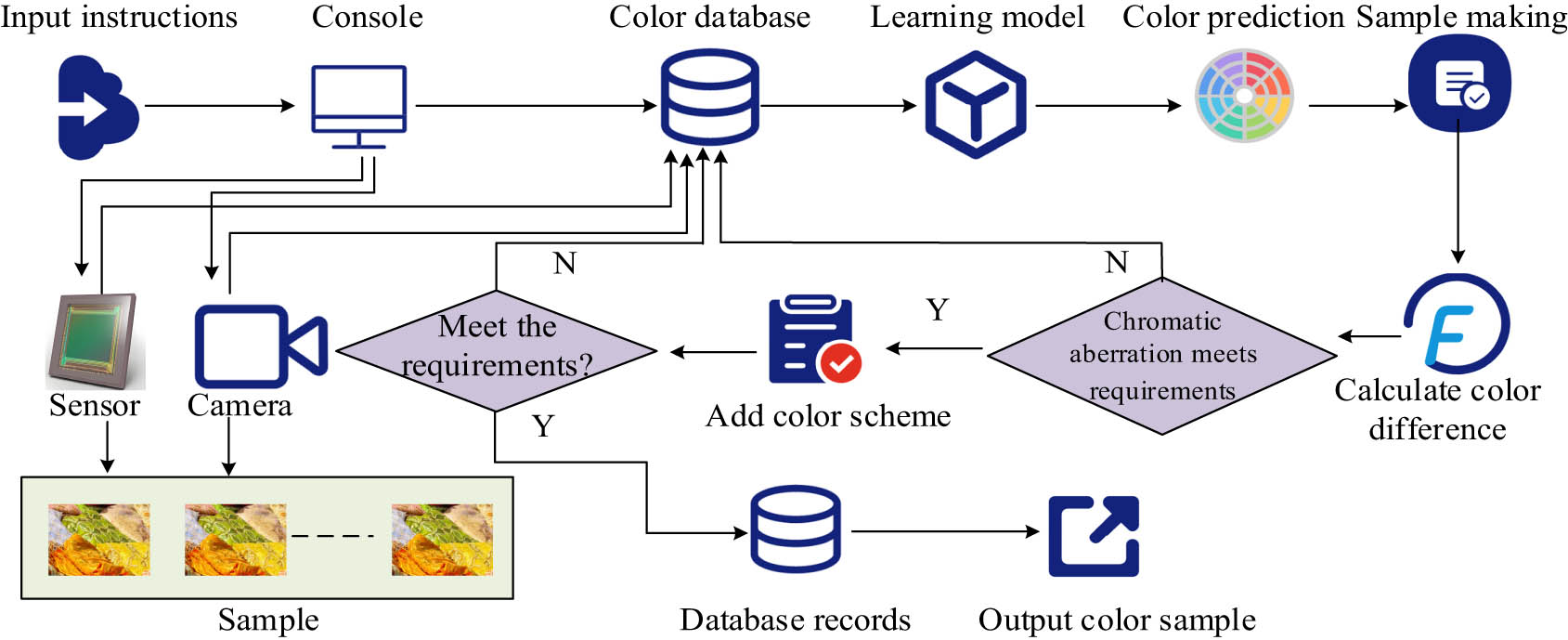
Basic structure of intelligent color-matching learning model.
From Figure 4, in the intelligent color-matching learning model, the user inputs instructions and passes them to the console. Through the commands output by the console, the image sensor and camera take the color of the sample and enter it into the color database. Next, through the learning model, the color is matched, and the color-matching prediction is output. Then, the color is sampled and the color difference with the sample color is calculated. If the color difference reaches the minimum requirement, a color-matching scheme is added to the finished product production. If it does not meet the requirements, the formula and the original data are returned to the color-matching database, and the color formula is searched again until the color difference meets the requirements. Afterwards, it is determined whether the finished product meets the requirements. If it meets the requirements, the color scheme is output and entered into the color sample database for next use. If it does not meet the requirements, the color scheme and original data are re-entered into the learning model through the color database until the requirements are met. Then, it will output and record the color scheme. The basic framework of the learning model in the intelligent color-matching model is shown in Figure 5.
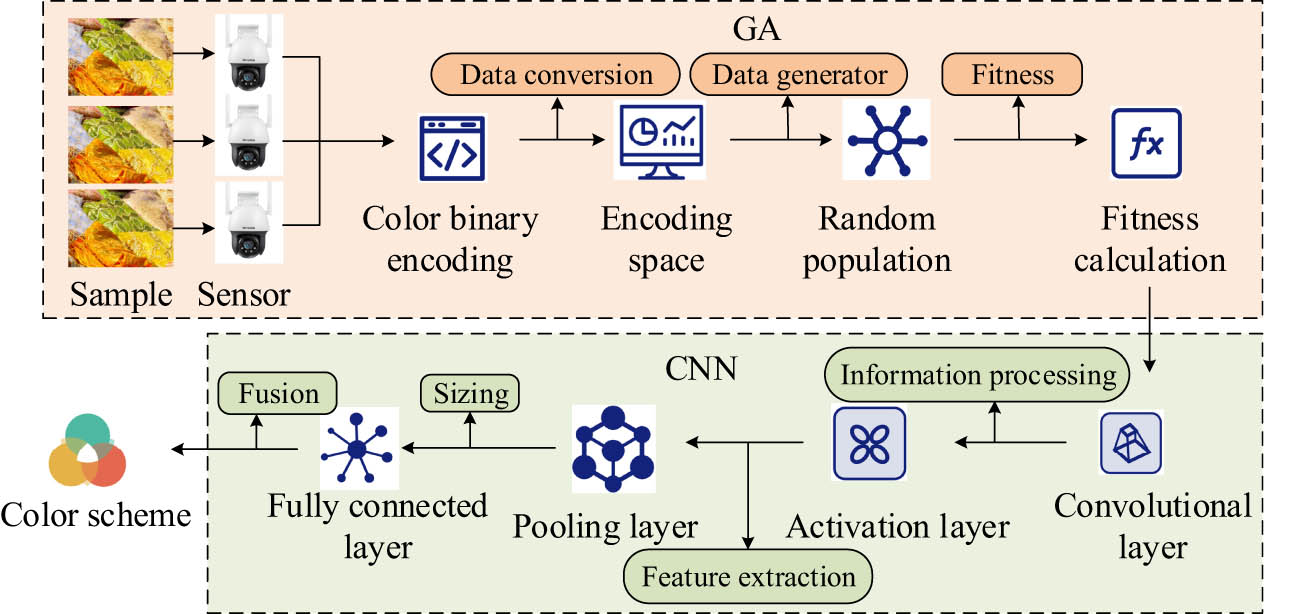
Basic framework of the learning model.
In Figure 5, the learning model consists of a data preprocessing module and a data analysis module. The data preprocessing module is composed of the GA, while the data analysis module is composed of the CNN algorithm. It inputs the template color into the input layer of the GA module, receives the input data in the input layer, performs binary encoding on the input color information, inputs all information into the encoding space, sets parameters to randomly generate the initial population of colors, and then performs fitness calculation to determine whether it meets the termination rule. If it meets the requirements, it will output the information to the CNN data analysis module. If it does not, it will perform selection, crossover, and mutation operator genetic operations on it and then perform fitness calculation on the color information until the termination rule is met. In the data analysis module, the preprocessed color information data is received, and all feature information in the sample colors is extracted through the calculation of convolutional layers, activation layers, pooling layers, and fully connected layers. Finally, the extracted color-matching samples are output. The surface color of textiles is formed by their reflection of incident light. The colorization feature expression on reflection spectrum matching is shown in the following equation:
In Eq. (12),
In Eq. (13),
In practical applications, the least squares method is used to minimize the difference between the matching color and the sample color, as shown in the following equation:
In Eq. (15),
In Eq. (16),
3 Results
3.1 Performance comparison and analysis of improved CNN algorithms
To validate the prediction performance of the study-proposed GA-CNN, this experiment selected four algorithms for comparison: BP neural network algorithm based on the Bayesian algorithm (NB-BP), improved CNN algorithm based on the harmony algorithm (HS-CNN), and optimized particle swarm optimization (PSO) algorithm. The configuration of the experimental environment is shown in Table 2.
Experimental environment configuration
| Experimental environment | Configure | Type |
|---|---|---|
| Hardware environment | Computer | Windows10 |
| Camera | TP-Link IPC44AW | |
| Software environment | Application server | SQL Server2000 |
| Program design platform | VC++ | |
| Data analysis | MATLAB R2017b |
According to Table 2, the environmental configuration conditions for the experiment were determined. Afterwards, the sensitivity of algorithm parameters was analyzed, and the analysis results are shown in Table 3.
Parameter sensitivity analysis of the algorithm
| Algorithm | Parameter | Sensitivity coefficient | Short-cut process | Algorithm accuracy (%) | Algorithm | Parameter | Sensitivity coefficient | Short-cut process | Algorithm accuracy |
|---|---|---|---|---|---|---|---|---|---|
| GA, BP, HS, CNN, PSO | Population size | 0.87 | 150 | 89.3 | CNN | Learning rate | 0.89 | 0.05 | 88.9 |
| 200 | 96.5 | 0.1 | 92.3 | ||||||
| 250 | 92.1 | 0.15 | 89.2 | ||||||
| Maximum iteration times | 0.91 | 200 | 90.3 | Weight decay | 0.94 | 0.004 | 90.2 | ||
| 300 | 96.7 | 0.005 | 96.5 | ||||||
| 400 | 89.9 | 0.006 | 90.6 | ||||||
| GA | Probability of variation | 0.92 | 0.04 | 90.4 | HS | Audio fine-tuning probability | 0.92 | 0.2 | 90.3 |
| 0.05 | 98.8 | 0.3 | 95.6 | ||||||
| 0.06 | 92.3 | 0.4 | 91.2 | ||||||
| Cross probability | 0.86 | 0.07 | 89.2 | PSO | Inertial weight | 0.93 | 0.5 | 89.9 | |
| 0.08 | 93.5 | 0.6 | 97.6 | ||||||
| 0.09 | 87.7 | 0.7 | 93.7 |
The sensitivity coefficient in Table 3 represents the degree of influence of the parameter on the results of the algorithm, and the larger the value, the greater the impact of the parameter on the algorithm performance. According to the analysis results in Table 3 and the experimental results of previous scholars on the algorithm, it can be seen that the parameter settings for optimal algorithm performance are as follows: the population size of GA, HS, BP, and CNN algorithms was set to 200, and the maximum number of iterations was set to 300 [19]. The mutation probability of GA was set to 0.05, and the crossover probability was set to 0.08 [20]. The learning rate in the CNN algorithm was set to 0.1, and the weight decay was set to 0.005 [21]. The probability of HS algorithm audio fine-tuning was set to 0.3. The inertia weight of the PSO algorithm was set to 0.6 [22]. The performance of the four algorithms was judged by analyzing their fitting degree, accuracy, error rate, and F1 value. The comparison of the accuracy and error rate of the four algorithms is shown in Figure 6.
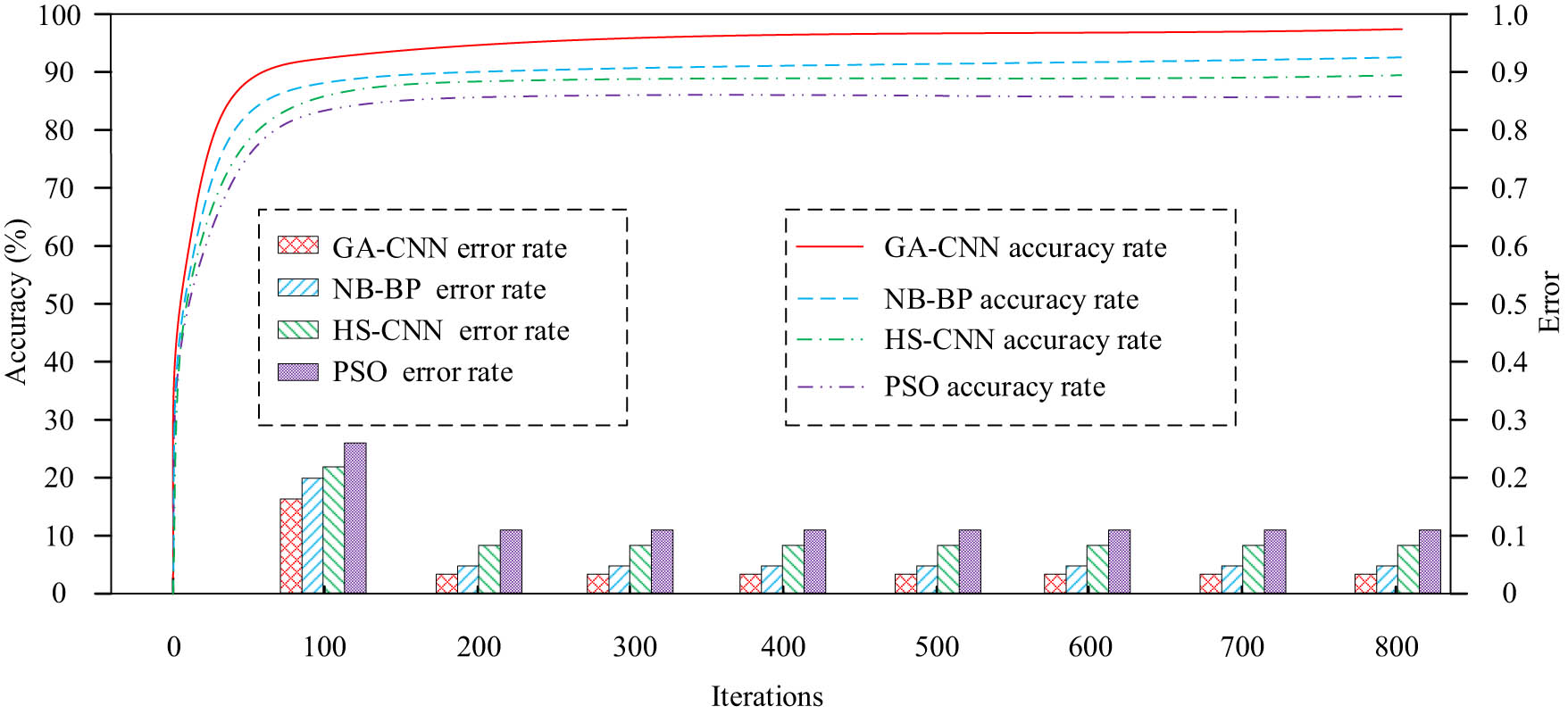
Comparison of error rate and accuracy of the algorithm.
From Figure 6, after reaching 100 iterations, the accuracy of the four algorithms roughly stabilized. The accuracy of the GA-CNN algorithm finally reached 98%, which was much higher than the NB-BP algorithm’s 92% HS-CNN algorithm’s 87% and PSO algorithm’s 79%. From the bar chart in Figure 6, the error rates of the four algorithms gradually stabilized after reaching 200 iterations. Finally, the error rates of GA-CNN, NB-BP, HS-CNN, and PSO algorithms were 0.02, 0.05, 0.09, and 0.12, respectively. The GA-CNN algorithm had the smallest error. This result indicates that the GA-CNN algorithm has a small difference between the predicted results and the actual results when using data for prediction and a high degree of consistency with the true values. Further comparative experiments were conducted on the fitting degree of the four algorithms, and the experimental results are indicated in Figure 7.
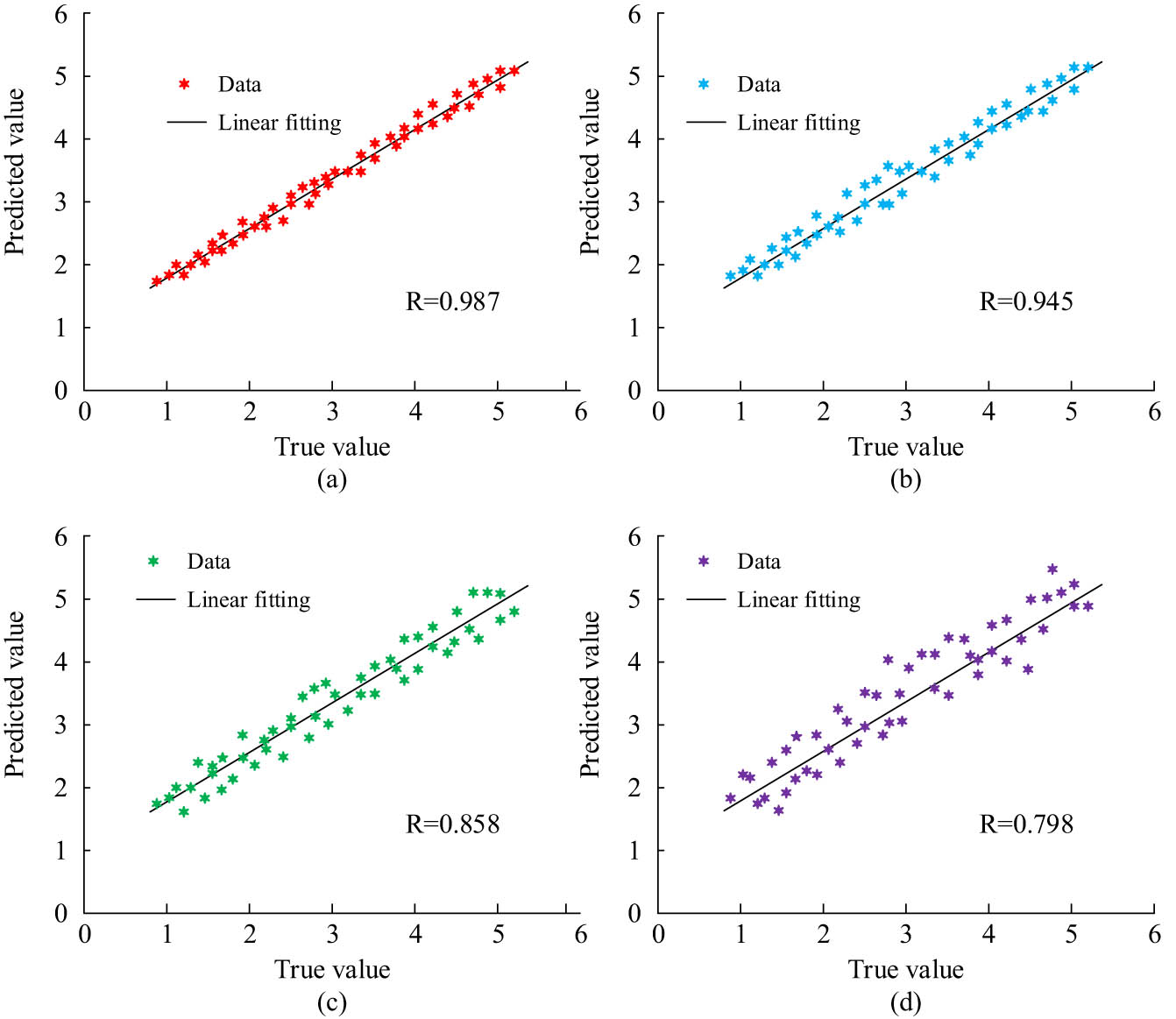
Comparison of the fit degree of four algorithms. (a) GA-CNN result of fit degree. (b) NB-BP result of fit degree. (c) HS-CNN result of fit degree. (d) PSO result of fit degree.
From the distribution of scatter points in Figure 7, the fitting degree of the four algorithms was the highest, among which the GA-CNN algorithm had the highest fitting degree. The data points in Figure 7(a) were almost all clustered around the regression line, and the fitting coefficient R reached 0.987, indicating the best-fitting effect. The fitting degree of the NB-BP algorithm was slightly lower than that of the GA-CNN algorithm. The degree of aggregation between the points in the coordinate graph of the algorithm was smaller than that of the GA-CNN algorithm, with a fitting coefficient of 0.945. The fitting degree coefficients of the HS-CNN algorithm and the PSO algorithm were 0.858 and 0.798, respectively, indicating that the fitting effect is much lower than that of the GA-CNN algorithm. According to the experimental results, the GA-CNN algorithm has the highest fitting coefficient, indicating that the closer the distance between the predicted data and the actual observed values during data training, the better the algorithm can capture patterns and features in the data. Therefore, among the four algorithms, the prediction results of the GA-CNN algorithm were most consistent with the actual results. Further comparative experimental analysis was conducted on the F1 values and loss function values of the four algorithms, and the experiment findings are indicated in Figure 8.
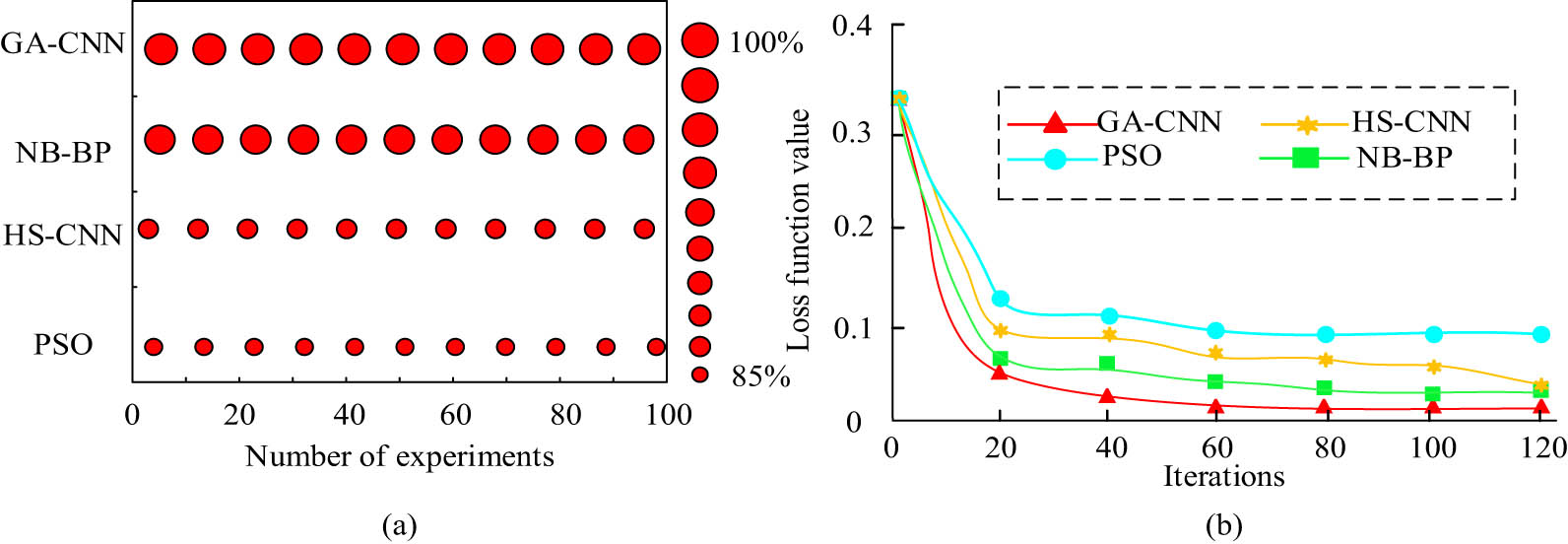
Comparison of F1 values and loss function values for four algorithms. (a) Comparison of algorithm F1 values. (b) Loss function value.
According to Figure 8(a), the F1 values of GA-CNN, NB-VP, HS-CNN, and PSO algorithms were 98.87, 95.54, 90.76, and 89.78%, respectively. The F1 value formula is the harmonic mean of accuracy and recall, used to comprehensively evaluate the accuracy and recall of algorithms. The larger the F1 value, the stronger the overall performance of the algorithm. As shown in Figure 8(a), the highest F1 value of the proposed GA-CNN algorithm indicated that the algorithm performed better in accuracy and recall. From Figure 8(b), the loss function values of the four algorithms decreased with the increase of iteration times. When the iteration number reached 40, the loss function value of the GA-CNN algorithm stabilized to 0.001, the final loss function value of the NB-BP algorithm also stabilized to 0.003, the HS-CNN algorithm was 0.005, and the PSO algorithm was 0.013. From this result, it can be concluded that the F1 value of the GA-CNN algorithm is optimal, indicating that the GA-CNN algorithm has a good balance performance between accuracy and recall. If the loss function value of the GA-CNN algorithm is the lowest, it means that the difference between the predicted results and the actual results of the algorithm is smaller, indicating that the performance of this algorithm is better than other algorithms. Therefore, the F1 value and loss function value of the GA-CNN algorithm were superior to other algorithms among the four algorithms. After a series of experimental analysis, it was known that the accuracy, stability, and other performance aspects of the GA-CNN algorithm proposed in this study were all optimal.
3.2 Analysis of the effect of intelligent color-matching learning model
Subsequently, comparative experiments were conducted on the intelligent color-matching learning model, including the GA-CNN algorithm-based, the NB-BP algorithm-based, the HS-CNN algorithm-based, and the PSO algorithm-based intelligent color-matching models. During the experiment, color-matching data of various clothing, gauze, and other materials from a large textile factory were selected as the experimental dataset. The intelligent color-matching model first used cameras and sensors to capture information about various materials in the textile factory, transmitted the obtained images to the model, analyzed the image information using the intelligent color-matching model, and performed color matching. Finally, the simulated colors of the model were compared with the actual colors. The accuracy, error rate, stability, matthews correlation coefficient (MCC), and color difference of textiles after using the color-matching model were tested. The accuracy and error rates of the four models are shown in Figure 9.
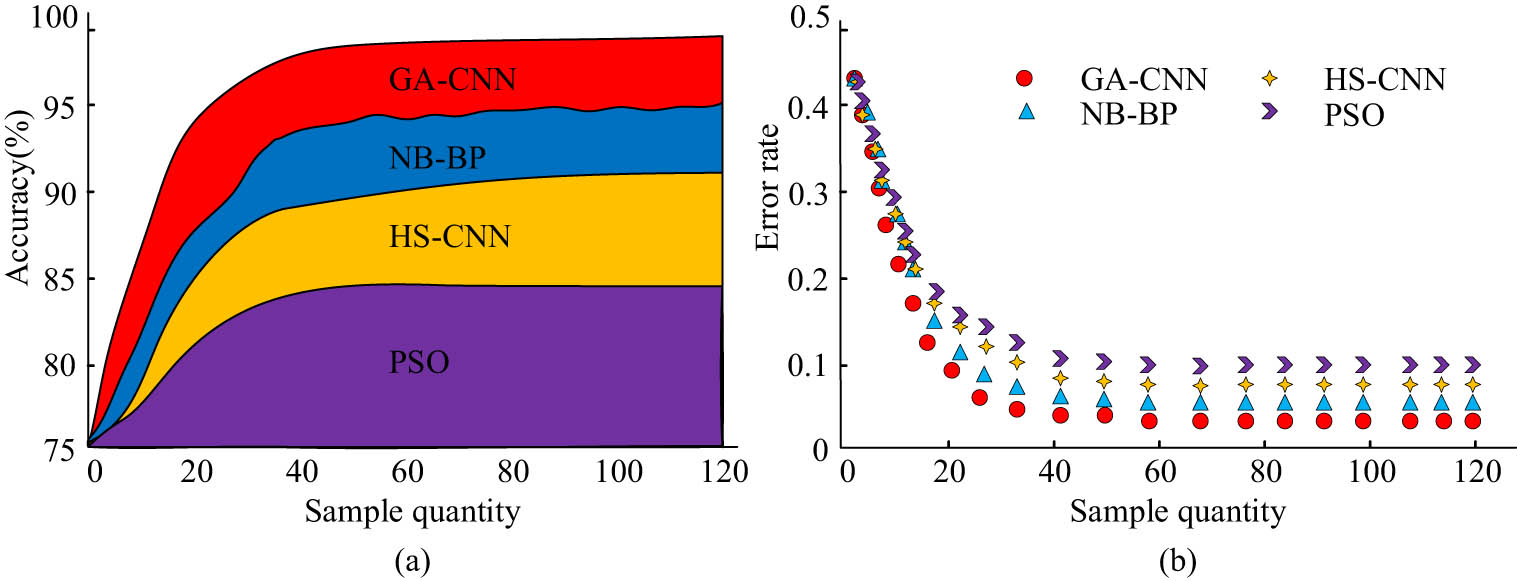
Comparison of accuracy and error rates of four models. (a) and (b) F1 value of each algorithm.
In Figure 9(a), the accuracy of the four models increased with the increase of sample size. Among them, the accuracy of GA-CNN stabilized at 98% after the sample size reached 40, and the accuracy of the NB-BP model stabilized at 93%. However, the accuracy of this model was unstable, fluctuating between 92 and 94%. The accuracy of the HS-CNN model remained stable at 86%, while the accuracy of the PSO model was the lowest at 83%. As shown in Figure 9(b), the error rates of the four models decreased with the increase of sample size. Among them, the error rate of the GA-CNN model decreased to the minimum value of 0.02 and remained stable after its sample size was 40. The error rates of the NB-BP model and the HS-CNN model were 0.06 and 0.09, respectively. The error rate of the PSO model was the largest among the four models, which was 0.12. From this result, it can be seen that the GA-CNN model has the highest color-matching accuracy among the four models after multiple trainings and can accurately configure the colors of the samples through this model. The stability and MCC values of the four models were compared again, and the comparison outcomes are indicated in Figure 10.
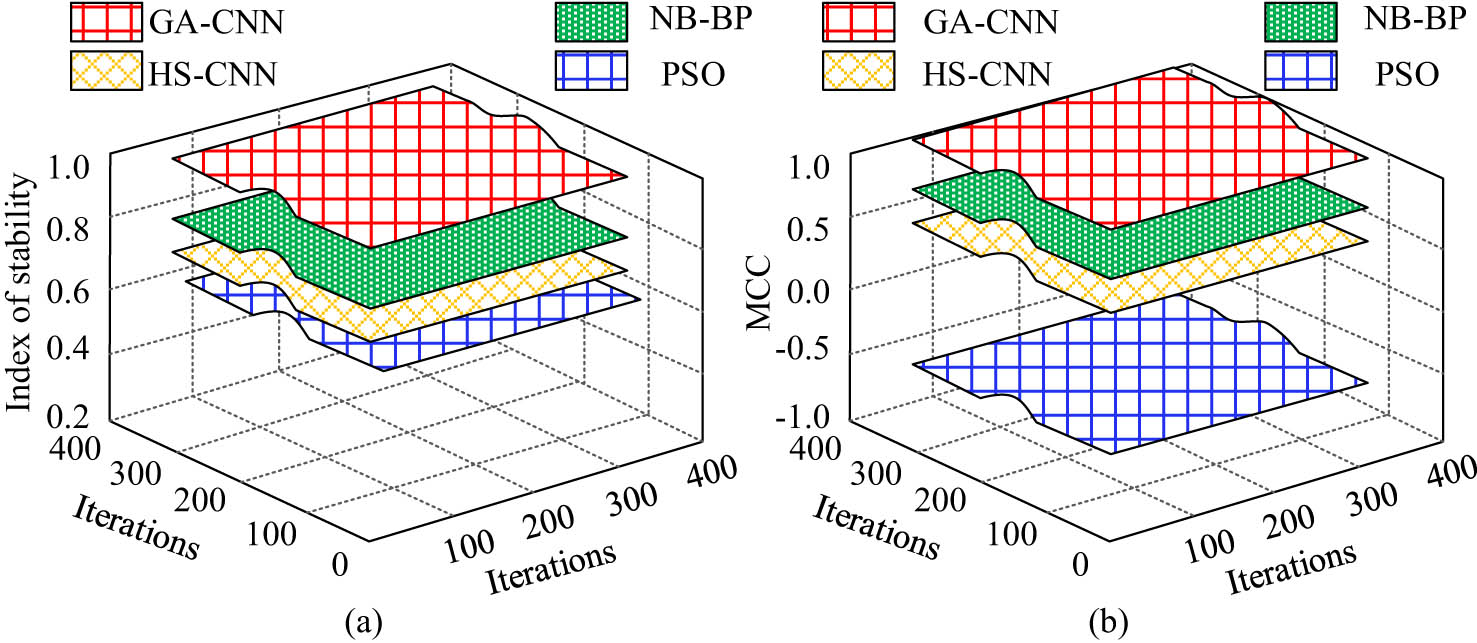
Comparison of MCC values and stability of four models. (a) Stability of four models. (b) MCC values for four models.
From Figure 10(a), the GA-CNN model had the best stability. When the number of iterations was 200, the stability of the model reached 0.9 and remained unchanged. However, the average stability rates of the NB-BP, HS-CNN, and PSO models were 0.78, 0.71, and 0.59, and the stability of the three models was lower than that of the GA-CNN model. From Figure 10(b), the MCC index of four models could be obtained, which was an indicator used to evaluate model performance. The range of MCC index was between −1 and 1. When the MCC index was 1, it indicated perfect prediction; when the index was 0, it indicated random prediction; and when the index was −1, it indicated completely opposite prediction. From the graph, when the number of iterations of the GA-CNN model was 200, the MCC index reached 1. The average MCC index of the NB-BP model and HS-CNN model were 0.76 and 0.46, respectively, indicating that the predictions of these two models are more accurate, while the average MCC index of the PSO model was −0.35, indicating a significant difference between the predicted and actual values. From this result, it can be concluded that the GA-CNN intelligent color-matching model has the best stability in color analysis of samples, and the model has the lowest difference between predicted colors and actual colors when predicting sample colors. Then, the intelligent color matching and actual color matching and color difference of the red, blue, and green colors of the four models were compared; the practical application of the model in the experiment is shown in Figure 11.
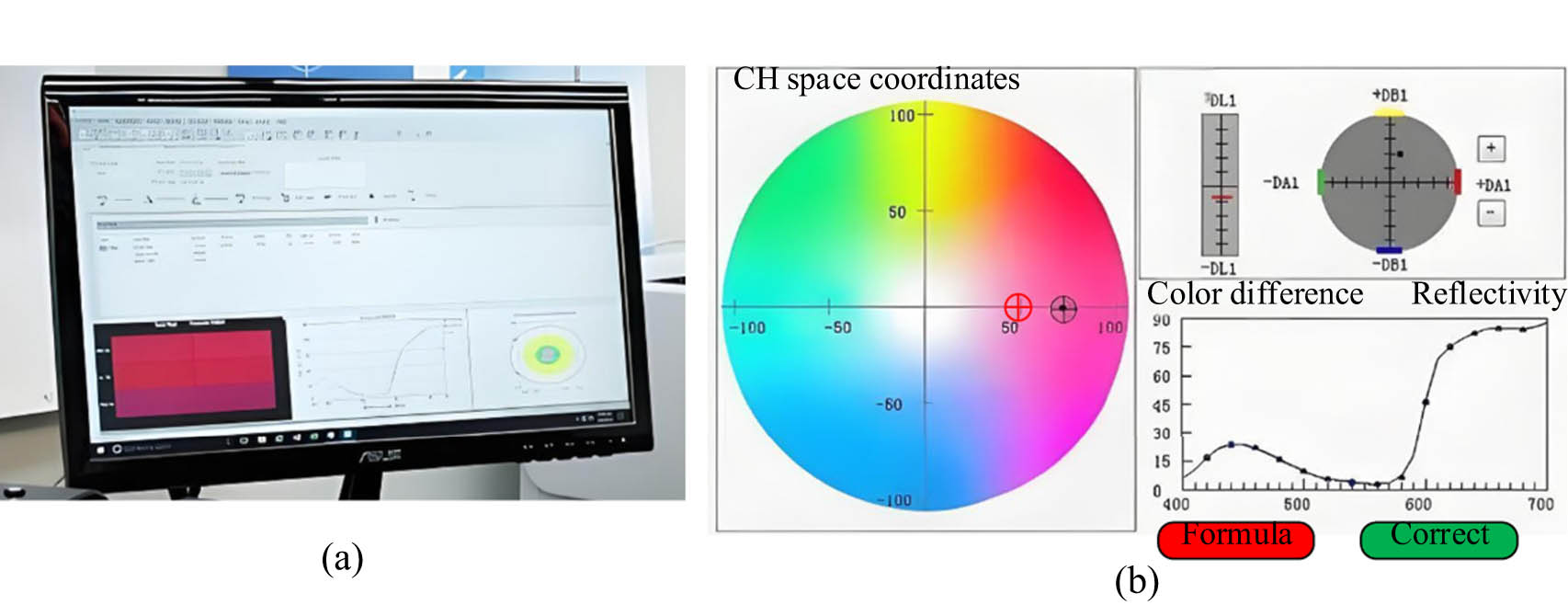
The practical application of the model. (a) Practical application diagram of intelligent color matching model. (b) Color adjustment.
The actual color and color of the model of Figure 11 and the comparison findings are denoted in Figure 12.
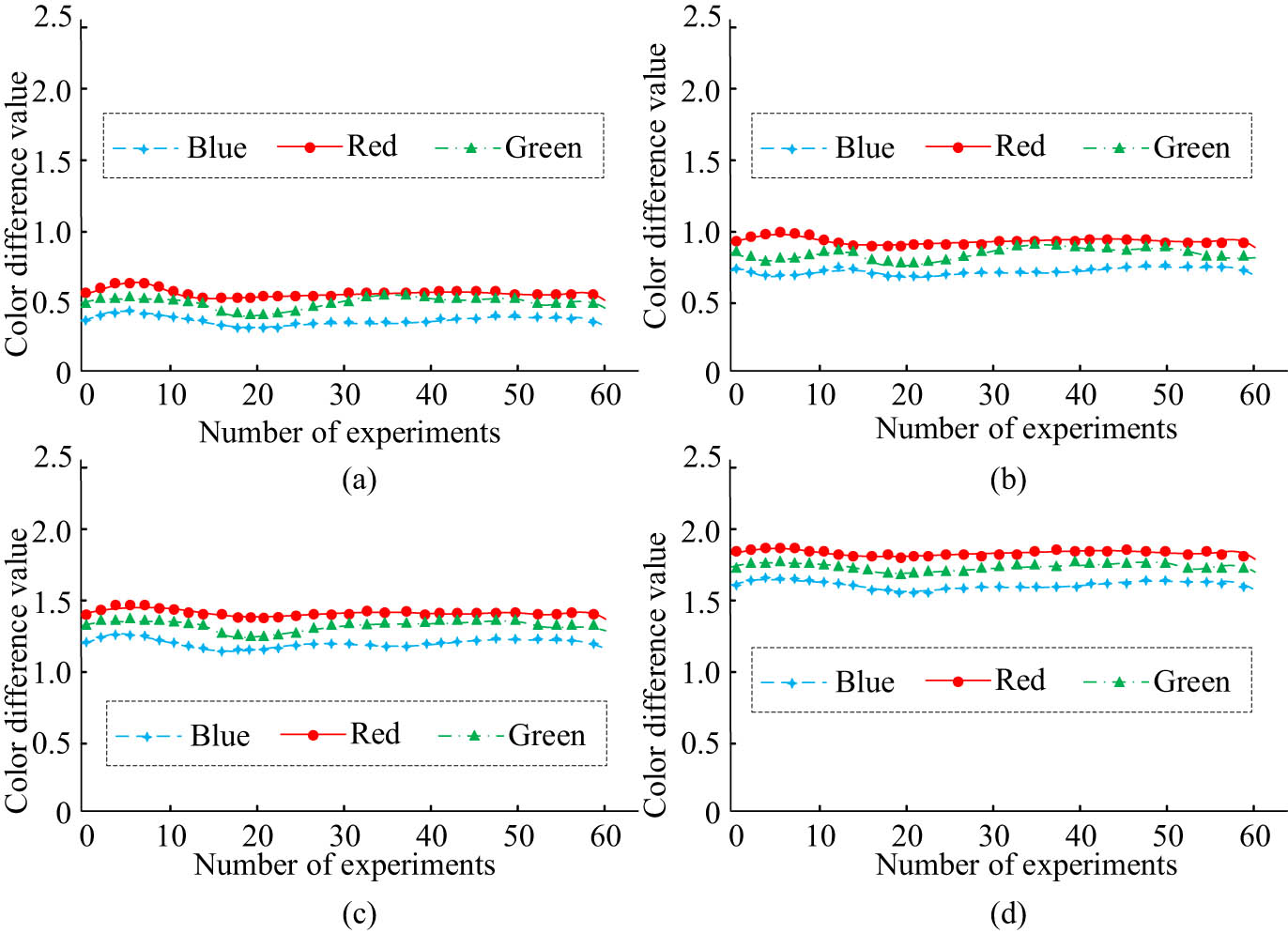
Color difference of red, green, and blue primary colors for four models. (a) GA-CNN, (b) NB-BP, (c) HS-CNN, and (d) PSO.
From Figure 12, in the color-matching simulation experiments of the four models for red, blue, and green colors, the GA-CNN color-matching model had the smallest color difference, with an average color difference of 0.51, 0.49, and 0.47 for the red, green, and blue primary colors, respectively. The NB-BP color-matching model had a color difference of 1.12, 0.91, and 0.82 for the red, green, and blue colors, respectively. The HS-CNN color-matching model had a color difference of 1.43, 1.32, and 1.25, and the PSO color-matching model had the largest color difference of 1.79, 1.63, and 1.54 among the four models. Among the four models, red had the largest color difference among the three primary colors, followed by green, and blue had the smallest color difference. From this result, it can be concluded that the GA-CNN model has the lowest color-matching error for the three primary colors, indicating that the model has the best color accuracy when performing sample color matching. In summary, by comparing the performance of different models in various aspects, it can be concluded that the GA-CNN intelligent color-matching model proposed in the study has the highest color-matching accuracy, the smallest error, and the strongest stability. In actual color matching, the GA-CNN intelligent color-matching model has the smallest color difference for the three primary colors of red, green, and blue, and the overall performance of the model is significantly better than other comparison models.
3.3 Discussion
This study conducted a comparative experimental analysis on the performance of the GA-CNN algorithm and conducted comparative experiments on intelligent color-matching learning models based on the GA-CNN, NB-BP, HS-CNN, and PSO algorithms. The results of this study denoted that the accuracy of the GA-CNN algorithm was 98%, which was much higher than the NB-BP algorithm’s 92% HS-CNN algorithm’s 87%, and PSO algorithm’s 79%. This result was similar to the experimental results of Wang’s team; however, the accuracy of the improved CNN algorithm used by the Wang team was lower than the GA-CNN algorithm in this study [23]. In the fitting experiment of the algorithm, the experiment findings denoted that the fitting coefficient R of the GA-CNN algorithm was 0.987, while the fitting coefficients R of the NB-BP, HS-CNN, and PSO algorithms were 0.945, 0.858, and 0.798, respectively. The GA-CNN algorithm had the best-fitting degree. This result coincided with the experiment findings of Li et al. However, the improved CNN algorithm proposed by Li et al. had a high fit but low accuracy, and the GA-CNN algorithm could improve the accuracy of the CNN algorithm [24]. The study also conducted comparative experiments on the F1 values and loss function values of four algorithms. The F1 values of GA-CNN, NB-BP, HS-CNN, and PSO algorithms were 98.87, 95.54, 90.76, and 89.78%, respectively, with loss function values of 0.001, 0.003, 0.005, and 0.013. This result was similar to the research findings of Ma et al. [25]. From the above experimental results, the GA-CNN algorithm can improve the disadvantages of low accuracy and large loss function value and improve the overall performance of the previous CNN algorithm. Further comparative experiments were conducted on intelligent color-matching learning models using four algorithms. The experimental results showed that the accuracy of the GA-CNN, NB-BP, HS-CNN, and PSO models was 98, 93, 86, and 83%, respectively. This result was similar to the experimental results of Widiputra [26]. Further experiments were conducted on the stability and MCC values of the four models. The experiment findings indicated that the stability of the GA-CNN model reached 0.9, and the MCC value reached 1 at 200 iterations. The predictive stability and performance of this model were significantly better than those of other models. The experimental results coincided with the research findings of Dandapat and Mondal; however, the prediction stability was slightly lower than the GA-CNN model in the model proposed by Dandapat and Mondal [27]. The above experimental results indicated that the overall performance of the GA-CNN intelligent color-matching learning model was optimal, providing better color-matching schemes and improving color-matching efficiency and accuracy in the textile industry. Comparing the color differences of the red, blue, and green primary colors in the color samples simulated by the four models, the findings indicated that the proposed GA-CNN model had the smallest color difference among the color schemes simulated by the three primary colors. This result indicated that the color-matching effect of the GA-CNN intelligent color-matching learning model was the best in practical applications. This result was similar to the experimental results of the Hassan team [28]. In summary, the GA-CNN intelligent color-matching learning model has the highest color-matching accuracy, strongest stability, and fastest speed among the four models; it can improve the disadvantages of low stability and large waste of resources in previous models. Applying this model to textile color matching can raise the speed and accuracy of color matching in the textile industry.
4 Conclusion and future work
To solve the problems of low color-matching accuracy and incomplete color-matching model functions in the textile industry, this study integrated GA and CNN algorithms, proposed the GA-CNN algorithm, and innovatively proposed an intelligent color-matching learning model based on the GA-CNN algorithm. The performance of the GA-CNN algorithm and color-matching model was tested. The study conducted experiments on the proposed algorithm, NB-BP algorithm, HS-CNN algorithm, PSO algorithm, and intelligent color-matching learning models based on four algorithms. The experimental results showed that among the four algorithms, the GA-CNN algorithm proposed in the study had the best accuracy and fitting coefficient, and the accuracy of this algorithm was the highest, the loss function value was the lowest, and the accuracy and F1 value of the algorithm were far superior to other algorithms. Further analysis of the intelligent color-matching learning models based on four algorithms showed that among the four models, the GA-CNN model had the highest color-matching accuracy, the best MCC value, and the best stability. In practical applications, the GA-CNN model had the smallest color difference among the three primary colors of red, blue, and green in the color-matching samples simulated by the four models. From this, the GA-CNN intelligent color-matching learning model has the highest accuracy, efficiency, and minimum color difference, resulting in the best overall performance. Therefore, the GA-CNN intelligent color-matching model proposed in this study can provide efficient, accurate, and environmentally friendly color-matching solutions for society by reducing the color-matching time, reducing the cost, and improving the color-matching efficiency, and significantly improving the production efficiency and product quality of various industries. The contribution of this study is that the proposed intelligent color-matching model can reduce color uncertainty, shorten product development cycles, and improve production efficiency by improving color-matching efficiency. Moreover, digital color matching can precisely control the amount of pigment used, reducing costs. In addition, this intelligent color-matching model can also be used to improve work efficiency in other industries such as coatings, paints, and printing.
However, in practical applications, the GA-CNN method is highly sensitive to image changes. If the image undergoes rotation or scaling, it may result in poor recognition performance and reduce color-matching accuracy. External factors such as air humidity and dust can also have a certain impact on the color of samples and experimental products. In response to the above issues, attention mechanisms and generative adversarial networks can be introduced into the GA-CNN method in the future to improve its adaptability to images. It can be combined with transfer learning, unsupervised learning, and other techniques to improve the flexibility of the algorithm so that the model can better handle the influence of external temperature, air, and other factors on product color.
-
Funding information: Authors state no funding involved.
-
Author contributions: All authors have accepted responsibility for the entire content of this manuscript and approved its submission.
-
Conflict of interest: Authors state no conflict of interest.
-
Data availability statement: All data generated or analysed during this study are included in this published article.
Appendix
% x and y are experimental datasets, and the model is the model trained on the data
x = [1 2 3 4 5];
y = [2 4 6 8 10];
model = GA-CNN;
% Parameter initialization
b 0 = [0];
% Fitting was performed using the lsqcurvefit
opts = optimoptions(‘lsqcurvefit’, ‘Algorithm’, ‘trust-region-reflective’);
[b, fval, exitflag, output] = lsqcurvefit(@(b, x) model(b, x) − y, b 0, x, opts);
% The fit degree was calculated
fitness = sum((model(b, x) − y).^2);
disp([‘degree of fitting (SSD):’ num2str(fitness)]);
Precision:
% Suppose a predictive array and an actual array
predictions = [1, 0, 1, 0, 1];
labels = [1, 1, 0, 0, 0];
% Calculate accuracy
accuracy = sum(predictions == labels)/length(labels);
% Display accuracy
disp([‘Algorithm accuracy:’, num2str(accuracy)]);
error rate:
% Suppose that predicted is the vector of predictive values of the algorithm and that actual is the vector of actual values
predicted = [1.2, 2.3, 3.5, 4.7, 5.1];
actual = [1.0, 2.1, 3.3, 4.8, 5.2];
% Calculate error rate
num_samples = length(predicted);
mse = sum((predicted – actual).^2)/num_samples;
rmse = sqrt(mse); % RMSE (Root Mean Squared Error)
% Displays the results
disp([‘MSE:’, num2str(mse)]);
disp([‘RMSE:’, num2str(rmse)]);
References
[1] Bandewad G, Datta KP, Gawali BW, Pawar SN. Review on discrimination of hazardous gases by smart sensing technology. Artif Intell Appl. 2023;1(2):86–97.10.47852/bonviewAIA3202434Suche in Google Scholar
[2] Guan X, Li W, Huang Q, Huang J. Intelligent color matching model for wood dyeing using genetic algorithm and extreme learning machine. J Intell Fuzzy Syst. 2022;42(6):4907–17.10.3233/JIFS-210618Suche in Google Scholar
[3] Zhang L, Li M, Sun Y, Liu X, Xu B, Zhang L. Color matching design simulation platform based on collaborative collective intelligence. CCF Trans Pervasive Comput Interact. 2022;4(1):61–75.10.1007/s42486-022-00088-4Suche in Google Scholar
[4] Yang R, He C, Pan B, Wang Z. Color-matching model of digital rotor spinning viscose mélange yarn based on the Kubelka–Munk theory. Text Res J. 2022;92(3–4):574–84.10.1177/00405175211040871Suche in Google Scholar
[5] Taylor JET, Taylor GW. Artificial cognition: How experimental psychology can help generate explainable artificial intelligence. Psychono Bull Rev. 2021;28(2):454–75.10.3758/s13423-020-01825-5Suche in Google Scholar PubMed
[6] Calderaro J, Kather JN. Artificial intelligence-based pathology for gastrointestinal and hepatobiliary cancers. Gut. 2021;70(6):1183–93.10.1136/gutjnl-2020-322880Suche in Google Scholar PubMed
[7] Ahmed I, Zhang Y, Jeon G, Lin W. A blockchain-and artificial intelligence-enabled smart IoT framework for sustainable city. Int J Intell Syst. 2022;37(9):6493–507.10.1002/int.22852Suche in Google Scholar
[8] Kattenborn T, Leitloff J, Schiefer F, Hinz S. Review on convolutional neural networks (CNN) in vegetation remote sensing. ISPRS J Photogramm Remote Sens. 2021;173:24–49.10.1016/j.isprsjprs.2020.12.010Suche in Google Scholar
[9] Lu W, Li J, Wang J, Qin L. A CNN-BiLSTM-AM method for stock price prediction. Neural Comput Appl. 2021;33(10):4741–53.10.1007/s00521-020-05532-zSuche in Google Scholar
[10] Zhang B, Sheng W, Wu D, Zhang R. Application of GA-ACO algorithm in thin slab continuous casting breakout prediction. Trans Indian Inst Met. 2023;76(1):145–55.10.1007/s12666-022-02732-0Suche in Google Scholar
[11] Yu J, Wang M, Yu JH, Arefzadeh SM. A new approach for task managing in the fog-based medical cyber-physical systems using a hybrid algorithm. Circuit World. 2023;49(3):294–304.10.1108/CW-03-2020-0035Suche in Google Scholar
[12] Ayar M, Isazadeh A, Gharehchopogh FS, Seyedi M. Chaotic-based divide-and-conquer feature selection method and its application in cardiac arrhythmia classification. J Supercomput. 2022;78(4):1–27.10.1007/s11227-021-04108-5Suche in Google Scholar
[13] Gharehchopogh FS, Ibrikci T. An improved African vultures optimization algorithm using different fitness functions for multi-level thresholding image segmentation. Multimed Tools Appl. 2024;83(6):16929–75.10.1007/s11042-023-16300-1Suche in Google Scholar
[14] Bayoudh K, Hamdaoui F, Mtibaa A. Transfer learning based hybrid 2D-3D CNN for traffic sign recognition and semantic road detection applied in advanced driver assistance systems. Appl Intell. 2021;51(1):124–42.10.1007/s10489-020-01801-5Suche in Google Scholar
[15] Zhang Q, Xiao J, Tian C, Chun-Wei Lin J, Zhang S. A robust deformed convolutional neural network (CNN) for image denoising. CAAI Trans Intell Technol. 2023;8(2):331–42.10.1049/cit2.12110Suche in Google Scholar
[16] Moghaddasi K, Rajabi S, Gharehchopogh FS, Ghaffari A. An advanced deep reinforcement learning algorithm for three-layer D2D-edge-cloud computing architecture for efficient task offloading in the Internet of Things. Sustain Comput Inform Syst. 2024;43:100992.10.1016/j.suscom.2024.100992Suche in Google Scholar
[17] Hussien AG, Gharehchopogh FS, Bouaouda A, Kumar S, Hu G. Recent applications and advances of African vultures optimization algorithm. Artif Intell Rev. 2024;57(12):1–51.10.1007/s10462-024-10981-2Suche in Google Scholar
[18] Barbhuiya AA, Karsh RK, Jain R. CNN based feature extraction and classification for sign language. Multimed Tools Appl. 2021;80(2):3051–69.10.1007/s11042-020-09829-ySuche in Google Scholar
[19] Huber H, Edenhofer S, von Tresckow J, Robrecht S, Zhang C, Tausch E, et al. Obinutuzumab (GA-101), ibrutinib, and venetoclax (GIVe) frontline treatment for high-risk chronic lymphocytic leukemia. Blood. 2022;139(9):1318–29.10.1182/blood.2021013208Suche in Google Scholar PubMed
[20] Olayah F, Senan EM, Ahmed IA, Awaji B. AI techniques of dermoscopy image analysis for the early detection of skin lesions based on combined CNN features. Diagnostics. 2023;13(7):1314–6.10.3390/diagnostics13071314Suche in Google Scholar PubMed PubMed Central
[21] Opata CE. Voltage profile improvement and power loss minimization of new haven injection substation for optimal placement of DG using harmony search algorithm optimization technique. Glob J Eng Technol Adv. 2023;15(1):90–101.10.30574/gjeta.2023.15.1.0051Suche in Google Scholar
[22] Huang T, Zhang Q, Tang X, Zhao S, Lu X. A novel fault diagnosis method based on CNN and LSTM and its application in fault diagnosis for complex systems. Artif Intell Rev. 2022;55(2):1289–315.10.1007/s10462-021-09993-zSuche in Google Scholar
[23] Wang J, Wu D, Gao Y, Wang X, Li X, Xu G, et al. Integral real-time locomotion mode recognition based on GA-CNN for lower limb exoskeleton. J Bionic Eng. 2022;19(5):1359–73.10.1007/s42235-022-00230-zSuche in Google Scholar
[24] Li Y, Wang Y, Wang R, Wang Y, Wang K, Wang X. GA-CNN: Convolutional neural network based on geometric algebra for hyperspectral image classification. IEEE Trans Geosci Remote Sens. 2022;60(8):1–14.10.1109/TGRS.2022.3212682Suche in Google Scholar
[25] Ma C, Shi Y, Huang Y, Dai G. Raman spectroscopy-based prediction of ofloxacin concentration in solution using a novel loss function and an improved GA-CNN model. BMC Bioinform. 2023;24(1):409–12.10.1186/s12859-023-05542-3Suche in Google Scholar PubMed PubMed Central
[26] Widiputra H. GA-optimized multivariate CNN-LSTM model for predicting multi-channel mobility in the COVID-19 pandemic. Emerg Sci J. 2021;5(5):619–35.10.28991/esj-2021-01300Suche in Google Scholar
[27] Dandapat A, Mondal B. Design of intrusion detection system using GA and CNN for MQTT-based IoT networks. Wireless Pers Commun. 2024;134(4):2059–82.10.1007/s11277-024-10984-wSuche in Google Scholar
[28] Hassan MR, Ismail WN, Chowdhury A, Hossain S, Huda S, Hassan MM. A framework of genetic algorithm-based CNN on multi-access edge computing for automated detection of COVID-19. J Supercomput. 2022;78(7):10250–74.10.1007/s11227-021-04222-4Suche in Google Scholar PubMed PubMed Central
© 2025 the author(s), published by De Gruyter
This work is licensed under the Creative Commons Attribution 4.0 International License.
Artikel in diesem Heft
- Research Articles
- Generalized (ψ,φ)-contraction to investigate Volterra integral inclusions and fractal fractional PDEs in super-metric space with numerical experiments
- Solitons in ultrasound imaging: Exploring applications and enhancements via the Westervelt equation
- Stochastic improved Simpson for solving nonlinear fractional-order systems using product integration rules
- Exploring dynamical features like bifurcation assessment, sensitivity visualization, and solitary wave solutions of the integrable Akbota equation
- Research on surface defect detection method and optimization of paper-plastic composite bag based on improved combined segmentation algorithm
- Impact the sulphur content in Iraqi crude oil on the mechanical properties and corrosion behaviour of carbon steel in various types of API 5L pipelines and ASTM 106 grade B
- Unravelling quiescent optical solitons: An exploration of the complex Ginzburg–Landau equation with nonlinear chromatic dispersion and self-phase modulation
- Perturbation-iteration approach for fractional-order logistic differential equations
- Variational formulations for the Euler and Navier–Stokes systems in fluid mechanics and related models
- Rotor response to unbalanced load and system performance considering variable bearing profile
- DeepFowl: Disease prediction from chicken excreta images using deep learning
- Channel flow of Ellis fluid due to cilia motion
- A case study of fractional-order varicella virus model to nonlinear dynamics strategy for control and prevalence
- Multi-point estimation weldment recognition and estimation of pose with data-driven robotics design
- Analysis of Hall current and nonuniform heating effects on magneto-convection between vertically aligned plates under the influence of electric and magnetic fields
- A comparative study on residual power series method and differential transform method through the time-fractional telegraph equation
- Insights from the nonlinear Schrödinger–Hirota equation with chromatic dispersion: Dynamics in fiber–optic communication
- Mathematical analysis of Jeffrey ferrofluid on stretching surface with the Darcy–Forchheimer model
- Exploring the interaction between lump, stripe and double-stripe, and periodic wave solutions of the Konopelchenko–Dubrovsky–Kaup–Kupershmidt system
- Computational investigation of tuberculosis and HIV/AIDS co-infection in fuzzy environment
- Signature verification by geometry and image processing
- Theoretical and numerical approach for quantifying sensitivity to system parameters of nonlinear systems
- Chaotic behaviors, stability, and solitary wave propagations of M-fractional LWE equation in magneto-electro-elastic circular rod
- Dynamic analysis and optimization of syphilis spread: Simulations, integrating treatment and public health interventions
- Visco-thermoelastic rectangular plate under uniform loading: A study of deflection
- Threshold dynamics and optimal control of an epidemiological smoking model
- Numerical computational model for an unsteady hybrid nanofluid flow in a porous medium past an MHD rotating sheet
- Regression prediction model of fabric brightness based on light and shadow reconstruction of layered images
- Dynamics and prevention of gemini virus infection in red chili crops studied with generalized fractional operator: Analysis and modeling
- Qualitative analysis on existence and stability of nonlinear fractional dynamic equations on time scales
- Fractional-order super-twisting sliding mode active disturbance rejection control for electro-hydraulic position servo systems
- Analytical exploration and parametric insights into optical solitons in magneto-optic waveguides: Advances in nonlinear dynamics for applied sciences
- Bifurcation dynamics and optical soliton structures in the nonlinear Schrödinger–Bopp–Podolsky system
- User profiling in university libraries by combining multi-perspective clustering algorithm and reader behavior analysis
- Review Article
- Haar wavelet collocation method for existence and numerical solutions of fourth-order integro-differential equations with bounded coefficients
- Special Issue: Nonlinear Analysis and Design of Communication Networks for IoT Applications - Part II
- Silicon-based all-optical wavelength converter for on-chip optical interconnection
- Research on a path-tracking control system of unmanned rollers based on an optimization algorithm and real-time feedback
- Analysis of the sports action recognition model based on the LSTM recurrent neural network
- Industrial robot trajectory error compensation based on enhanced transfer convolutional neural networks
- Research on IoT network performance prediction model of power grid warehouse based on nonlinear GA-BP neural network
- Interactive recommendation of social network communication between cities based on GNN and user preferences
- Application of improved P-BEM in time varying channel prediction in 5G high-speed mobile communication system
- Construction of a BIM smart building collaborative design model combining the Internet of Things
- Optimizing malicious website prediction: An advanced XGBoost-based machine learning model
- Economic operation analysis of the power grid combining communication network and distributed optimization algorithm
- Sports video temporal action detection technology based on an improved MSST algorithm
- Internet of things data security and privacy protection based on improved federated learning
- Enterprise power emission reduction technology based on the LSTM–SVM model
- Construction of multi-style face models based on artistic image generation algorithms
- Research and application of interactive digital twin monitoring system for photovoltaic power station based on global perception
- Special Issue: Decision and Control in Nonlinear Systems - Part II
- Animation video frame prediction based on ConvGRU fine-grained synthesis flow
- Application of GGNN inference propagation model for martial art intensity evaluation
- Benefit evaluation of building energy-saving renovation projects based on BWM weighting method
- Deep neural network application in real-time economic dispatch and frequency control of microgrids
- Real-time force/position control of soft growing robots: A data-driven model predictive approach
- Mechanical product design and manufacturing system based on CNN and server optimization algorithm
- Application of finite element analysis in the formal analysis of ancient architectural plaque section
- Research on territorial spatial planning based on data mining and geographic information visualization
- Fault diagnosis of agricultural sprinkler irrigation machinery equipment based on machine vision
- Closure technology of large span steel truss arch bridge with temporarily fixed edge supports
- Intelligent accounting question-answering robot based on a large language model and knowledge graph
- Analysis of manufacturing and retailer blockchain decision based on resource recyclability
- Flexible manufacturing workshop mechanical processing and product scheduling algorithm based on MES
- Exploration of indoor environment perception and design model based on virtual reality technology
- Tennis automatic ball-picking robot based on image object detection and positioning technology
- A new CNN deep learning model for computer-intelligent color matching
- Design of AR-based general computer technology experiment demonstration platform
- Indoor environment monitoring method based on the fusion of audio recognition and video patrol features
- Health condition prediction method of the computer numerical control machine tool parts by ensembling digital twins and improved LSTM networks
- Establishment of a green degree evaluation model for wall materials based on lifecycle
- Quantitative evaluation of college music teaching pronunciation based on nonlinear feature extraction
- Multi-index nonlinear robust virtual synchronous generator control method for microgrid inverters
- Manufacturing engineering production line scheduling management technology integrating availability constraints and heuristic rules
- Analysis of digital intelligent financial audit system based on improved BiLSTM neural network
- Attention community discovery model applied to complex network information analysis
- A neural collaborative filtering recommendation algorithm based on attention mechanism and contrastive learning
- Rehabilitation training method for motor dysfunction based on video stream matching
- Research on façade design for cold-region buildings based on artificial neural networks and parametric modeling techniques
- Intelligent implementation of muscle strain identification algorithm in Mi health exercise induced waist muscle strain
- Optimization design of urban rainwater and flood drainage system based on SWMM
- Improved GA for construction progress and cost management in construction projects
- Evaluation and prediction of SVM parameters in engineering cost based on random forest hybrid optimization
- Museum intelligent warning system based on wireless data module
- Optimization design and research of mechatronics based on torque motor control algorithm
- Special Issue: Nonlinear Engineering’s significance in Materials Science
- Experimental research on the degradation of chemical industrial wastewater by combined hydrodynamic cavitation based on nonlinear dynamic model
- Study on low-cycle fatigue life of nickel-based superalloy GH4586 at various temperatures
- Some results of solutions to neutral stochastic functional operator-differential equations
- Ultrasonic cavitation did not occur in high-pressure CO2 liquid
- Research on the performance of a novel type of cemented filler material for coal mine opening and filling
- Testing of recycled fine aggregate concrete’s mechanical properties using recycled fine aggregate concrete and research on technology for highway construction
- A modified fuzzy TOPSIS approach for the condition assessment of existing bridges
- Nonlinear structural and vibration analysis of straddle monorail pantograph under random excitations
- Achieving high efficiency and stability in blue OLEDs: Role of wide-gap hosts and emitter interactions
- Construction of teaching quality evaluation model of online dance teaching course based on improved PSO-BPNN
- Enhanced electrical conductivity and electromagnetic shielding properties of multi-component polymer/graphite nanocomposites prepared by solid-state shear milling
- Optimization of thermal characteristics of buried composite phase-change energy storage walls based on nonlinear engineering methods
- A higher-performance big data-based movie recommendation system
- Nonlinear impact of minimum wage on labor employment in China
- Nonlinear comprehensive evaluation method based on information entropy and discrimination optimization
- Application of numerical calculation methods in stability analysis of pile foundation under complex foundation conditions
- Research on the contribution of shale gas development and utilization in Sichuan Province to carbon peak based on the PSA process
- Characteristics of tight oil reservoirs and their impact on seepage flow from a nonlinear engineering perspective
- Nonlinear deformation decomposition and mode identification of plane structures via orthogonal theory
- Numerical simulation of damage mechanism in rock with cracks impacted by self-excited pulsed jet based on SPH-FEM coupling method: The perspective of nonlinear engineering and materials science
- Cross-scale modeling and collaborative optimization of ethanol-catalyzed coupling to produce C4 olefins: Nonlinear modeling and collaborative optimization strategies
- Unequal width T-node stress concentration factor analysis of stiffened rectangular steel pipe concrete
- Special Issue: Advances in Nonlinear Dynamics and Control
- Development of a cognitive blood glucose–insulin control strategy design for a nonlinear diabetic patient model
- Big data-based optimized model of building design in the context of rural revitalization
- Multi-UAV assisted air-to-ground data collection for ground sensors with unknown positions
- Design of urban and rural elderly care public areas integrating person-environment fit theory
- Application of lossless signal transmission technology in piano timbre recognition
- Application of improved GA in optimizing rural tourism routes
- Architectural animation generation system based on AL-GAN algorithm
- Advanced sentiment analysis in online shopping: Implementing LSTM models analyzing E-commerce user sentiments
- Intelligent recommendation algorithm for piano tracks based on the CNN model
- Visualization of large-scale user association feature data based on a nonlinear dimensionality reduction method
- Low-carbon economic optimization of microgrid clusters based on an energy interaction operation strategy
- Optimization effect of video data extraction and search based on Faster-RCNN hybrid model on intelligent information systems
- Construction of image segmentation system combining TC and swarm intelligence algorithm
- Particle swarm optimization and fuzzy C-means clustering algorithm for the adhesive layer defect detection
- Optimization of student learning status by instructional intervention decision-making techniques incorporating reinforcement learning
- Fuzzy model-based stabilization control and state estimation of nonlinear systems
- Optimization of distribution network scheduling based on BA and photovoltaic uncertainty
- Tai Chi movement segmentation and recognition on the grounds of multi-sensor data fusion and the DBSCAN algorithm
- Special Issue: Dynamic Engineering and Control Methods for the Nonlinear Systems - Part III
- Generalized numerical RKM method for solving sixth-order fractional partial differential equations
Artikel in diesem Heft
- Research Articles
- Generalized (ψ,φ)-contraction to investigate Volterra integral inclusions and fractal fractional PDEs in super-metric space with numerical experiments
- Solitons in ultrasound imaging: Exploring applications and enhancements via the Westervelt equation
- Stochastic improved Simpson for solving nonlinear fractional-order systems using product integration rules
- Exploring dynamical features like bifurcation assessment, sensitivity visualization, and solitary wave solutions of the integrable Akbota equation
- Research on surface defect detection method and optimization of paper-plastic composite bag based on improved combined segmentation algorithm
- Impact the sulphur content in Iraqi crude oil on the mechanical properties and corrosion behaviour of carbon steel in various types of API 5L pipelines and ASTM 106 grade B
- Unravelling quiescent optical solitons: An exploration of the complex Ginzburg–Landau equation with nonlinear chromatic dispersion and self-phase modulation
- Perturbation-iteration approach for fractional-order logistic differential equations
- Variational formulations for the Euler and Navier–Stokes systems in fluid mechanics and related models
- Rotor response to unbalanced load and system performance considering variable bearing profile
- DeepFowl: Disease prediction from chicken excreta images using deep learning
- Channel flow of Ellis fluid due to cilia motion
- A case study of fractional-order varicella virus model to nonlinear dynamics strategy for control and prevalence
- Multi-point estimation weldment recognition and estimation of pose with data-driven robotics design
- Analysis of Hall current and nonuniform heating effects on magneto-convection between vertically aligned plates under the influence of electric and magnetic fields
- A comparative study on residual power series method and differential transform method through the time-fractional telegraph equation
- Insights from the nonlinear Schrödinger–Hirota equation with chromatic dispersion: Dynamics in fiber–optic communication
- Mathematical analysis of Jeffrey ferrofluid on stretching surface with the Darcy–Forchheimer model
- Exploring the interaction between lump, stripe and double-stripe, and periodic wave solutions of the Konopelchenko–Dubrovsky–Kaup–Kupershmidt system
- Computational investigation of tuberculosis and HIV/AIDS co-infection in fuzzy environment
- Signature verification by geometry and image processing
- Theoretical and numerical approach for quantifying sensitivity to system parameters of nonlinear systems
- Chaotic behaviors, stability, and solitary wave propagations of M-fractional LWE equation in magneto-electro-elastic circular rod
- Dynamic analysis and optimization of syphilis spread: Simulations, integrating treatment and public health interventions
- Visco-thermoelastic rectangular plate under uniform loading: A study of deflection
- Threshold dynamics and optimal control of an epidemiological smoking model
- Numerical computational model for an unsteady hybrid nanofluid flow in a porous medium past an MHD rotating sheet
- Regression prediction model of fabric brightness based on light and shadow reconstruction of layered images
- Dynamics and prevention of gemini virus infection in red chili crops studied with generalized fractional operator: Analysis and modeling
- Qualitative analysis on existence and stability of nonlinear fractional dynamic equations on time scales
- Fractional-order super-twisting sliding mode active disturbance rejection control for electro-hydraulic position servo systems
- Analytical exploration and parametric insights into optical solitons in magneto-optic waveguides: Advances in nonlinear dynamics for applied sciences
- Bifurcation dynamics and optical soliton structures in the nonlinear Schrödinger–Bopp–Podolsky system
- User profiling in university libraries by combining multi-perspective clustering algorithm and reader behavior analysis
- Review Article
- Haar wavelet collocation method for existence and numerical solutions of fourth-order integro-differential equations with bounded coefficients
- Special Issue: Nonlinear Analysis and Design of Communication Networks for IoT Applications - Part II
- Silicon-based all-optical wavelength converter for on-chip optical interconnection
- Research on a path-tracking control system of unmanned rollers based on an optimization algorithm and real-time feedback
- Analysis of the sports action recognition model based on the LSTM recurrent neural network
- Industrial robot trajectory error compensation based on enhanced transfer convolutional neural networks
- Research on IoT network performance prediction model of power grid warehouse based on nonlinear GA-BP neural network
- Interactive recommendation of social network communication between cities based on GNN and user preferences
- Application of improved P-BEM in time varying channel prediction in 5G high-speed mobile communication system
- Construction of a BIM smart building collaborative design model combining the Internet of Things
- Optimizing malicious website prediction: An advanced XGBoost-based machine learning model
- Economic operation analysis of the power grid combining communication network and distributed optimization algorithm
- Sports video temporal action detection technology based on an improved MSST algorithm
- Internet of things data security and privacy protection based on improved federated learning
- Enterprise power emission reduction technology based on the LSTM–SVM model
- Construction of multi-style face models based on artistic image generation algorithms
- Research and application of interactive digital twin monitoring system for photovoltaic power station based on global perception
- Special Issue: Decision and Control in Nonlinear Systems - Part II
- Animation video frame prediction based on ConvGRU fine-grained synthesis flow
- Application of GGNN inference propagation model for martial art intensity evaluation
- Benefit evaluation of building energy-saving renovation projects based on BWM weighting method
- Deep neural network application in real-time economic dispatch and frequency control of microgrids
- Real-time force/position control of soft growing robots: A data-driven model predictive approach
- Mechanical product design and manufacturing system based on CNN and server optimization algorithm
- Application of finite element analysis in the formal analysis of ancient architectural plaque section
- Research on territorial spatial planning based on data mining and geographic information visualization
- Fault diagnosis of agricultural sprinkler irrigation machinery equipment based on machine vision
- Closure technology of large span steel truss arch bridge with temporarily fixed edge supports
- Intelligent accounting question-answering robot based on a large language model and knowledge graph
- Analysis of manufacturing and retailer blockchain decision based on resource recyclability
- Flexible manufacturing workshop mechanical processing and product scheduling algorithm based on MES
- Exploration of indoor environment perception and design model based on virtual reality technology
- Tennis automatic ball-picking robot based on image object detection and positioning technology
- A new CNN deep learning model for computer-intelligent color matching
- Design of AR-based general computer technology experiment demonstration platform
- Indoor environment monitoring method based on the fusion of audio recognition and video patrol features
- Health condition prediction method of the computer numerical control machine tool parts by ensembling digital twins and improved LSTM networks
- Establishment of a green degree evaluation model for wall materials based on lifecycle
- Quantitative evaluation of college music teaching pronunciation based on nonlinear feature extraction
- Multi-index nonlinear robust virtual synchronous generator control method for microgrid inverters
- Manufacturing engineering production line scheduling management technology integrating availability constraints and heuristic rules
- Analysis of digital intelligent financial audit system based on improved BiLSTM neural network
- Attention community discovery model applied to complex network information analysis
- A neural collaborative filtering recommendation algorithm based on attention mechanism and contrastive learning
- Rehabilitation training method for motor dysfunction based on video stream matching
- Research on façade design for cold-region buildings based on artificial neural networks and parametric modeling techniques
- Intelligent implementation of muscle strain identification algorithm in Mi health exercise induced waist muscle strain
- Optimization design of urban rainwater and flood drainage system based on SWMM
- Improved GA for construction progress and cost management in construction projects
- Evaluation and prediction of SVM parameters in engineering cost based on random forest hybrid optimization
- Museum intelligent warning system based on wireless data module
- Optimization design and research of mechatronics based on torque motor control algorithm
- Special Issue: Nonlinear Engineering’s significance in Materials Science
- Experimental research on the degradation of chemical industrial wastewater by combined hydrodynamic cavitation based on nonlinear dynamic model
- Study on low-cycle fatigue life of nickel-based superalloy GH4586 at various temperatures
- Some results of solutions to neutral stochastic functional operator-differential equations
- Ultrasonic cavitation did not occur in high-pressure CO2 liquid
- Research on the performance of a novel type of cemented filler material for coal mine opening and filling
- Testing of recycled fine aggregate concrete’s mechanical properties using recycled fine aggregate concrete and research on technology for highway construction
- A modified fuzzy TOPSIS approach for the condition assessment of existing bridges
- Nonlinear structural and vibration analysis of straddle monorail pantograph under random excitations
- Achieving high efficiency and stability in blue OLEDs: Role of wide-gap hosts and emitter interactions
- Construction of teaching quality evaluation model of online dance teaching course based on improved PSO-BPNN
- Enhanced electrical conductivity and electromagnetic shielding properties of multi-component polymer/graphite nanocomposites prepared by solid-state shear milling
- Optimization of thermal characteristics of buried composite phase-change energy storage walls based on nonlinear engineering methods
- A higher-performance big data-based movie recommendation system
- Nonlinear impact of minimum wage on labor employment in China
- Nonlinear comprehensive evaluation method based on information entropy and discrimination optimization
- Application of numerical calculation methods in stability analysis of pile foundation under complex foundation conditions
- Research on the contribution of shale gas development and utilization in Sichuan Province to carbon peak based on the PSA process
- Characteristics of tight oil reservoirs and their impact on seepage flow from a nonlinear engineering perspective
- Nonlinear deformation decomposition and mode identification of plane structures via orthogonal theory
- Numerical simulation of damage mechanism in rock with cracks impacted by self-excited pulsed jet based on SPH-FEM coupling method: The perspective of nonlinear engineering and materials science
- Cross-scale modeling and collaborative optimization of ethanol-catalyzed coupling to produce C4 olefins: Nonlinear modeling and collaborative optimization strategies
- Unequal width T-node stress concentration factor analysis of stiffened rectangular steel pipe concrete
- Special Issue: Advances in Nonlinear Dynamics and Control
- Development of a cognitive blood glucose–insulin control strategy design for a nonlinear diabetic patient model
- Big data-based optimized model of building design in the context of rural revitalization
- Multi-UAV assisted air-to-ground data collection for ground sensors with unknown positions
- Design of urban and rural elderly care public areas integrating person-environment fit theory
- Application of lossless signal transmission technology in piano timbre recognition
- Application of improved GA in optimizing rural tourism routes
- Architectural animation generation system based on AL-GAN algorithm
- Advanced sentiment analysis in online shopping: Implementing LSTM models analyzing E-commerce user sentiments
- Intelligent recommendation algorithm for piano tracks based on the CNN model
- Visualization of large-scale user association feature data based on a nonlinear dimensionality reduction method
- Low-carbon economic optimization of microgrid clusters based on an energy interaction operation strategy
- Optimization effect of video data extraction and search based on Faster-RCNN hybrid model on intelligent information systems
- Construction of image segmentation system combining TC and swarm intelligence algorithm
- Particle swarm optimization and fuzzy C-means clustering algorithm for the adhesive layer defect detection
- Optimization of student learning status by instructional intervention decision-making techniques incorporating reinforcement learning
- Fuzzy model-based stabilization control and state estimation of nonlinear systems
- Optimization of distribution network scheduling based on BA and photovoltaic uncertainty
- Tai Chi movement segmentation and recognition on the grounds of multi-sensor data fusion and the DBSCAN algorithm
- Special Issue: Dynamic Engineering and Control Methods for the Nonlinear Systems - Part III
- Generalized numerical RKM method for solving sixth-order fractional partial differential equations

